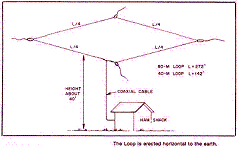
aka W0MHS Loop Skywire
aka Full Wave Loop Antenna
aka Magnetic Loop Antenna
Observations by Jason Buchanan - N1SU

|
Skywire Loop Antenna
aka W0MHS Loop Skywire aka Full Wave Loop Antenna aka Magnetic Loop Antenna Observations by Jason Buchanan - N1SU |
Some call it a Skywire Loop Antenna, some call it a W0MHS Loop
Skywire Antenna, nowadays it's called a Full Wave Loop Antenna
but it still is a force to be reckoned with. In the first couple hours of
having it up I was able to hear stations I could not hear before.
The skywire loop is an excellent antenna - they can be a bit of work to get up in the air if you have a lot of obstacles (trees, xyl, etc.) but it is worth it.
The length of a loop best suited for operation on 160 meters is too short for use on the higher bands. The optimal choice is to cut the loop for resonance on the highest band you plan to use, however it becomes difficult to use a giant 160 meter loop on 10 meters - your feedline length must not be a fractional wavelength of the band you want to use or else you'll wind up using your feedline as the radiator!
If you plan to use the loop for 160 meters 99% of the time then cut it for 160 meters @ 544' - but be prepared for difficulty and reduced performance above 7MHz.
I recommend a different loop for use on 20-10 meters if those are your favorite bands, mostly because it's easier to put up 71 feet of wire (14MHz) with only 18 feet per side. It's also easier to make a 23' diameter loop for 20 meters more circular instead of square shaped. Remember, the ideal loop is a perfect circle - it's not too hard to make an 8-sided loop for 20 meters using PVC pipe and some dacron rope to hold it rigid.
Polarity of the loop shouldn't matter but sometimes it does. The difference in polarity can be heard as some stations being much louder than others when the polarity is changed - i'm guessing this is due to cancellation of signals as received by the different length of the sides of my loop. A circular loop would reduce these effects.
I have an old DPDT copper knife switch that I use to switch the polarity of the 160 meter loop. My experiments with smaller loops, 20 meter loop for example, shows that the polarity plays very little role.
Performance is exceptional and rarely is beaten by a dipole at the same height.
Feedpoint location is important - it's preferable to have the feedpoint on the north side of the loop (or a side that faces a part of the world where there is little DX), especially if your loop is square. My loop's performance was increased by moving the feedpoint to the north side; stations to the south were easier to hear.
Corner feedpoint locations of square loops increase gain in the direction of the opposite corner. A loop fed in the southwest corner will have a few dB (3dB or more) gain favoring the northeast corner. The loop really, really cuts the mustard on 160, 80 and 40 meters compared to a dipole at the same height. It works just fine and dandy on 20 meters as well but I'd rather have a dedicated 20 meter loop for 20 through 10 meters. I had a separate loop for 20-10 and it was far easier to put up and maintain (a lot less wire to be targeted by nearby falling tree limbs).
11-Nov-06: Another 3 hours spent cutting more limbs and branches I didn't see near the end of the previous day.
21-Nov-06: I worked HC8N quite easily on 30 meters with 100 watts - big pileup but easy to work.
Winter 2007 - 544' to short - added another 20' - 15 meters is much easier to tune now
Spring 2008 - wire broke - my pulleys are too small, I should have used a 3" pulley at each corner. Added more wire - 574' is a great length.
I was wrong. A manual tuner is as easy as tuning a linear, ladder line is a misunderstood jewel, there's no such thing as an antenna that is too big, it was fairly simple to put up (even in my woodsy yard) and the performance makes up for whatever negatives are left over.
Ladder line has become my feedline of choice - RFI is greatly reduced and power levels are not a concern. My tuner will burn up before ladder line will.
|
|
| SkyWires |
| Visit this group |
More W4RNL pages:
Horizontally Oriented, Horizontally Polarized Large Wire Loop Antennas
Horizontal Wire Loops size
Some Notes on NVIS Cloud Burners
Some NVIS: From the Backyard to Professional Installations
More NVIS: Horizontal Heights